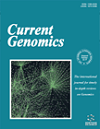- Home
- A-Z Publications
- Current Genomics
- Previous Issues
- Volume 12, Issue 2, 2011
Current Genomics - Volume 12, Issue 2, 2011
Volume 12, Issue 2, 2011
-
-
Editorial [Hot Topic: Genes Coding Industrially Relevant Enzymes in Fungi: Isolation and Protein Engineering of Laccases (Guest Editor: Vincenza Faraco)]
More LessIt is my great pleasure as a Guest Editor of the journal Current Genomics to present you with a ‘hot topic issue’ on fungal laccase genes. Fungi are sources of several enzymes susceptible of applications in many and diverse industrial segments such as food, beverage, textile, leather, paper and pulp, animal feed and fuel industry. These microorganisms are safe, display efficient growth under industrial production conditions and a Read More
-
-
-
Multiple Multi-Copper Oxidase Gene Families in Basidiomycetes - What for?
More LessAuthors: Ursula Kues and Martin RuhlGenome analyses revealed in various basidiomycetes the existence of multiple genes for blue multi-copper oxidases (MCOs). Whole genomes are now available from saprotrophs, white rot and brown rot species, plant and animal pathogens and ectomycorrhizal species. Total numbers (from 1 to 17) and types of mco genes differ between analyzed species with no easy to recognize connection of gene distribution to fungal life st Read More
-
-
-
Evolution of Multicopper Oxidase Genes in Coprophilous and Non-Coprophilous Members of the Order Sordariales
More LessMulticopper oxidases (MCO) catalyze the biological oxidation of various aromatic substrates and have been identified in plants, insects, bacteria, and wood rotting fungi. In nature, they are involved in biodegradation of biopolymers such as lignin and humic compounds, but have also been tested for various industrial applications. In fungi, MCOs have been shown to play important roles during their life cycles, such as in fruiti Read More
-
-
-
Induction and Transcriptional Regulation of Laccases in Fungi
More LessFungal laccases are phenol oxidases widely studied for their use in several industrial applications, including pulp bleaching in paper industry, dye decolourisation, detoxification of environmental pollutants and revalorization of wastes and wastewaters. The main difficulty in using these enzymes at industrial scale ensues from their production costs. Elucidation of the components and the mechanisms involved in regulation of lacca Read More
-
-
-
Directed Evolution of Fungal Laccases
More LessAuthors: Diana Mate, Eva Garcia-Ruiz, Susana Camarero and Miguel AlcaldeFungal laccases are generalists biocatalysts with potential applications that range from bioremediation to novel green processes. Fuelled by molecular oxygen, these enzymes can act on dozens of molecules of different chemical nature, and with the help of redox mediators, their spectrum of oxidizable substrates is further pushed towards xenobiotic compounds (pesticides, industrial dyes, PAHs), biopolymers (ligni Read More
-
-
-
Engineering Laccases: In Search for Novel Catalysts
More LessAuthors: Viviane Robert, Yasmina Mekmouche, Pierre R. Pailley and Thierry TronLaccases (p-diphenol oxidase, EC 1.10.3.2) are blue multicopper oxidases that catalyze the reduction of dioxygen to water, with a concomitant oxidation of small organic substrates. Since the description at the end of the nineteenth century of a factor catalyzing the rapid hardening of the latex of the Japanese lacquer trees (Rhus sp.) exposed to air laccases from different origins (plants, fungi bacteria) have been continuou Read More
-
-
-
Genetic and Epigenetic Signatures in Human Hepatocellular Carcinoma:A Systematic Review
More LessAuthors: Naoshi Nishida and Ajay GoelHepatocellular carcinoma (HCC) is the third most common cause of cancer deaths worldwide, and the incidence of this fatal disease is still on rise. The majority of HCCs emerge in the background of a chronic liver disease, such as chronic hepatitis and liver cirrhosis. The current understanding is that majority of HCCs evolve as a consequence of chronic inflammation and due to the presence of infection with hepatitis viruses. Th Read More
-
-
-
Genomic Diversity in Pig (Sus scrofa) and its Comparison with Human and other Livestock
More LessAuthors: Chunyan Zhang and Graham PlastowWe have reviewed the current pig (Sus scrofa) genomic diversity within and between sites and compared them with human and other livestock. The current Porcine 60K single nucleotide polymorphism (SNP) panel has an average SNP distance in a range of 30 - 40 kb. Most of genetic variation was distributed within populations, and only a small proportion of them existed between populations. The average heterozygosity was lo Read More
-
-
-
Recent Progress in Development of Tnt1 Functional Genomics Platform for Medicago truncatula and Lotus japonicus in Bulgaria
More LessLegumes, as protein-rich crops, are widely used for human food, animal feed and vegetable oil production. Over the past decade, two legume species, Medicago truncatula and Lotus japonicus, have been adopted as model legumes for genomics and physiological studies. The tobacco transposable element, Tnt1, is a powerful tool for insertional mutagenesis and gene inactivation in plants. A large collection of Tnt1-tagg Read More
-
Volumes & issues
-
Volume 26 (2025)
-
Volume 25 (2024)
-
Volume 24 (2023)
-
Volume 23 (2022)
-
Volume 22 (2021)
-
Volume 21 (2020)
-
Volume 20 (2019)
-
Volume 19 (2018)
-
Volume 18 (2017)
-
Volume 17 (2016)
-
Volume 16 (2015)
-
Volume 15 (2014)
-
Volume 14 (2013)
-
Volume 13 (2012)
-
Volume 12 (2011)
-
Volume 11 (2010)
-
Volume 10 (2009)
-
Volume 9 (2008)
-
Volume 8 (2007)
-
Volume 7 (2006)
-
Volume 6 (2005)
-
Volume 5 (2004)
-
Volume 4 (2003)
-
Volume 3 (2002)
-
Volume 2 (2001)
-
Volume 1 (2000)
Most Read This Month
Article
content/journals/cg
Journal
10
5
false
en


